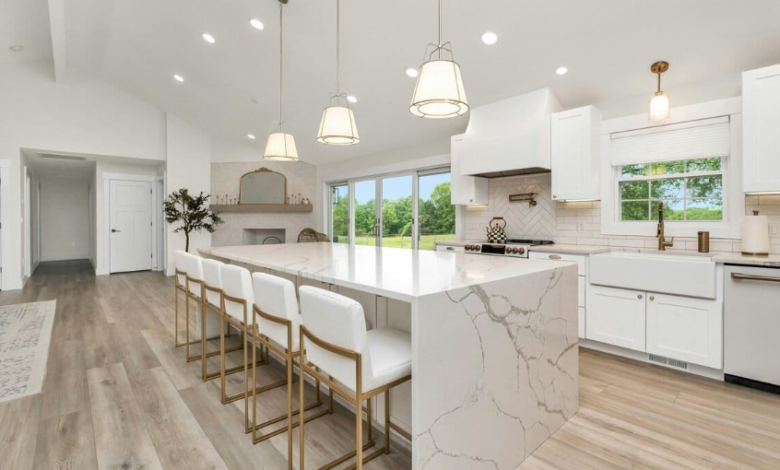Silestone Quartz Countertop Advantages for Modern Kitchen Designs

Silestone quartz countertops are engineered surfaces made primarily from natural quartz, combined with resins and pigments to create durable, non-porous countertops. They offer a balance of strength, stain resistance, and low maintenance, making them a popular choice for kitchens and bathrooms. The material also incorporates recycled content, reflecting a commitment to sustainability without compromising performance.
This engineered stone is recognized for its consistency in color and pattern, providing homeowners and designers with a wide range of stylish options that replicate the look of natural stone like granite or marble. Silestone’s innovative technology reduces hazardous silica content, enhancing safety during production while maintaining its high standards of quality.
With over 25 years in the market, Silestone has established itself as a reliable brand for those seeking long-lasting surfaces. Its combination of beauty, durability, and eco-friendly elements makes it a practical choice for both residential and commercial spaces.
Silestone Quartz Countertop Features
Silestone quartz countertop combines engineered materials with a broad range of design options, allowing for versatile applications. They offer a balance of aesthetic appeal, structural integrity, and resistance to everyday wear.
Material Composition
Silestone is primarily composed of approximately 90% natural quartz, one of the hardest minerals available. The quartz is combined with resins, pigments, and occasionally recycled glass to enhance both appearance and performance. This engineered blend creates a non-porous surface that is resistant to stains and bacteria.
The manufacturing process involves molding these components under high pressure, which ensures a consistent and durable surface. Additionally, Silestone uses sustainable practices such as recycled water and renewable energy during production, and its surfaces include at least 20% recycled materials.
Variety of Colors and Patterns
Silestone offers extensive customization with a variety of colors and patterns. These include options that resemble natural stones like granite and marble, as well as unique contemporary designs. The pigmentation process is integrated into the quartz mixture, resulting in consistent and vibrant colors throughout the slab.
This variety allows homeowners and designers to select surfaces that match diverse styles, from classic to modern. The uniformity of color and pattern across slabs also simplifies matching across large installations or multi-area projects.
See also: The Difference Between At-Home Skincare and Professional Treatments
Durability and Strength
Silestone countertops are highly durable, ranking among the hardest quartz surfaces on the market. Their non-porous nature makes them resistant to stains, scratches, and heat damage encountered in kitchens and bathrooms.
They can withstand daily use without losing color or texture, reducing maintenance needs. While resistant to moderate heat, using trivets for hot pots is still recommended to preserve the resin components. The engineered strength ensures long-lasting surfaces suitable for high-traffic environments.
Benefits and Considerations
Silestone quartz countertops offer a durable and visually appealing surface, but choosing them involves weighing financial, practical, and environmental factors. Understanding these aspects helps buyers make informed decisions based on their needs and constraints.
Cost Comparison
Silestone countertops typically fall into a mid-to-high price range compared to other countertop materials. They generally cost between $50 and $100 per square foot, depending on the color and finish. This price includes the material itself and sometimes basic fabrication.
When compared to natural stone like granite or marble, Silestone is often similarly priced or slightly more expensive. However, it tends to be more affordable than premium natural stones such as rare marbles. The long-term value is notable because Silestone’s durability means fewer replacements or repairs are likely.
Additional costs may arise if the installation requires custom shapes or complex edge treatments, which can increase labor expenses. It is important to factor in both upfront and potential long-term costs when evaluating Silestone’s price.
Installation Process
Installation of Silestone countertops requires skilled professionals experienced with engineered quartz. Silestone slabs are heavy and must be handled carefully to avoid cracks or chips during transport and fitting.
The process generally involves measuring, templating, cutting, and securing the countertop to cabinetry. Unlike natural stone, Silestone slabs have consistent thickness and density, which can make fitting more predictable.
Silestone can be cut and shaped using standard quartz fabrication tools, but installers must also consider space for seams, especially for larger countertops. The process usually takes 1 to 3 days, depending on the project size and complexity.
Proper sealing is not necessary, as Silestone is non-porous, but installers should still ensure edges and joins are sealed adequately to prevent moisture damage.
Maintenance Requirements
Silestone quartz countertops are low-maintenance due to their non-porous surface, which resists stains and bacterial growth. This makes regular cleaning straightforward—only mild soap and water or non-abrasive cleaners are needed.
Unlike natural stone, Silestone does not require periodic sealing, which reduces upkeep efforts and cost. It stands up well to heat, but users are advised to avoid placing extremely hot pots directly on the surface to prevent thermal shock.
Because it resists scratches, routine use typically does not affect its finish. Any spills should be wiped up quickly to maintain the surface’s integrity, although Silestone’s resistance limits absorption of common kitchen stains like wine or coffee.
Environmental Impact
Silestone prioritizes sustainability through the use of recycled materials and environmentally friendly manufacturing processes. Its composition includes a significant percentage of recycled content, reducing dependence on quarrying.
The brand uses Cosentino’s patented Hybriq+ technology, which lowers crystalline silica exposure during production, benefitting both workers and end users.
Compared to natural stone countertops, Silestone’s production generally has a smaller environmental footprint, especially considering mining and transport impacts of natural stone.
Consumers seeking eco-conscious choices will find Silestone a reasonable option, combining durability with practices aimed at lessening environmental harm.





